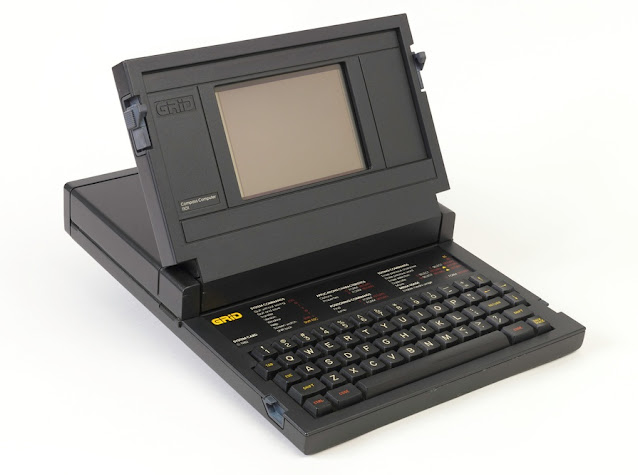Released April 1982
Even though practical microcomputers had only been around for a few years by 1982, there was a growing market for portable devices such as the Kaypro II which offered all the computing power you probably needed in a luggable package.
Back then people accepted that a portable computer would weigh something like 13 kg and come in a huge case. Practically speaking you’d typically carry it between a desk and car. Unlike modern “laptop” computers, most portables of the early 1980s would possibly break your knees if you tried to use them on the sofa.
 |
| GRiD Compass |
The first practical laptop computer is widely considered to be the GRiD Compass. A clamshell on the front of the device held a 320 x 240 pixel electroluminescent display and a keyboard in a format instantly recognisable today. Although the display was relatively small, it was sharp and clear compared to early LCD panels and the limited resolution was actually pretty competitive with most computers of the time.
Inside was an Intel 8086 CPU with an 8087 maths coprocessor, but this was no DOS-compatible computer. Instead the Compass ran a proprietary OS called GRID-OS which was menu-driven and quite friendly. One novelty was storage – the Compass used magnetic bubble memory giving 340Kb of non-volatile storage. Most production systems also included a modem, and an IEEE interface bus was standard. The lightweight but strong magnesium alloy case contributed to the relatively light weight of around 5 kg.
This was a highly advanced machine, and it came with a substantial price tag starting at $8500 in 1982 money which is around $25,000 today. OK, it is possible to spend more than that on a computer today (a high-end Mac Pro can cost $60,000 or more) but that was nearly six times the price of the Kaypro and to be honest it couldn’t do as much for a typical end user.
Where it did find a niche was in government sales. The tough but lightweight design lent itself well to military applications, and the Compass was also certified for use on board the Space Shuttle. Large corporations were drawn to it as a practical and highly portable device, but few found their way to private users due to the high price.
 |
| GRiD Compass running a spreadsheet |
This was the first in line of several GRiD systems, and on top of healthy sales they also owned a patent for several of the elements of the clamshell design, meaning that other laptop manufacturers had to pay GRiD a fee for each system built. GRiD was taken over by Tandy in 1988 followed by a management buyout in 1993 which moved the company from California to the UK. The company – now called GRiD Defence Systems – still makes ruggedized laptops and other hardware.
The Compass set the pattern for all modern laptop designs, years before they became commonplace. Today first-generation GRiD Compass systems are very rare and you can expect to pay between £5000 to £10000 for a working system.
Image credits:
Cooper Hewitt, Smithsonian Design Museum
Niall Kennedy via Flickr - CC BY-NC 2.0

No comments:
Post a Comment